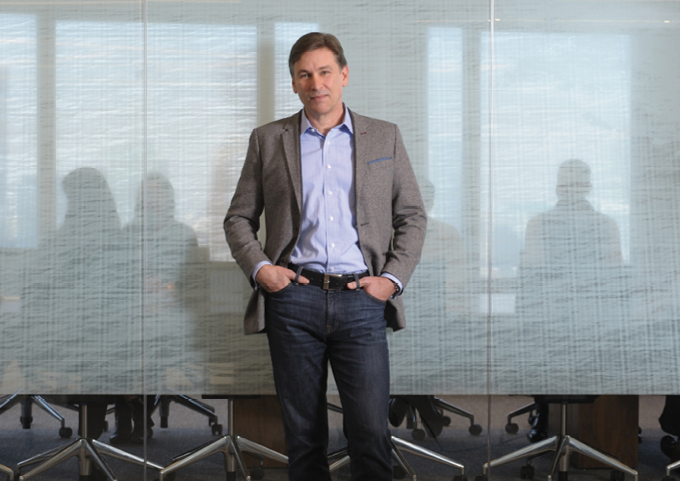Citi CLO Cameron Hedrick didn’t always dream of becoming a corporate executive. Hedrick began his career as a music composition major at Ouachita Baptist University in Arkansas. While studying, he joined a jazz combo and spent two years after graduation playing gigs across the country.
It was the early 1990s and his combo stayed busy, in large part due to their manager who was a successful municipal bond trader who also happened to be a jazz enthusiast. “He just loved jazz, and he took care of us,” said Hedrick. “Before gigs he used to teach us about money management and bonds.”
It was a fun life, but Hedrick eventually realized that he needed a more stable job, so his manager recommended him to a colleague at Fidelity Investments. “I spoke with a very senior fund manager at Fidelity,” Hedrick said. “I didn’t have the skills for any of the roles in his department, but he connected me with another colleague who took a chance on me.”
How to Pass Your Series 7
At Fidelity, Hedrick was hired as a customer service rep where he had to pass a Series 6 or Series 7 certification exam to trade mutual funds over the phone. At the time, turnover in that department was about 70 percent because most of the reps failed their exams. “Much to my surprise, I did well on the exam, so they asked me to teach the new hires,” he said.
Hedrick realized they could significantly improve pass rates if they changed their approach to hiring and training these reps. So, in addition to teaching the class, he worked with management to rethink the recruiting and screening process to be more selective about who they hired, then he analyzed and selected the right vendor to reframe the curriculum and implement practice exams that the reps had to pass before taking the real exams. “Within a year, we went from a 70 percent first-attempt fail rate to more than 90 percent passing,” he said.
Hedrick’s results quickly caught the attention of leadership and he was put into a high-potential program where he moved up the ranks, eventually taking the role of sales director responsible for performance support solutions in Boston. He spent a total of seven years at Fidelity in various leadership roles.
Hedrick left Fidelity in 2000 to join a start-up tech company called d-Tech with dreams of becoming a successful tech entrepreneur. The d-Tech leadership team grew the employee, partnership and revenue base substantially over three years. Acknowledging there were strategic differences with the majority owner, Hedrick and a partner decided to split off and form a new company.
Eventually, Hedrick realized he didn’t have the risk tolerance for another start-up experience, so he took some time off to evaluate his next career move. Within a few months, he was offered a role at Citi to create and implement a sales training program, and he jumped at the chance. “That was 15 years ago, and I never looked back.”

The Future of Learning
Over the next decade, Hedrick moved from sales training, to senior vice president of talent, to a leader in HR — first for the U.S. consumer side of the organization and later for the global commercial side.
It was an exciting journey, he said. Over the years, he learned the intricacies of HR in a financial services environment. During the financial crisis he was assigned to a restructuring team collectively tasked with laying off thousands of employees. “It was an extraordinary but sad time,” he said, noting that his area of focus was to restructure L&D in the Europe, the Middle East and Africa region.
But today Citi is thriving again, and when Hedrick was appointed CLO in 2016, he set in motion long-term plans to transform Citi’s learning organization to accommodate the future of work.
It’s the perfect time for someone like Hedrick to take on this leadership role, said Kevin Engholm, head of learning for Institutional Client’s Group, early career, ICG and enterprise infrastructure operations and technology. “Cameron is very future-focused,” he said.
He’s also an avid learner and his enthusiasm for learning and the potential impact it will have on the business is infectious, Engholm said. “He’s great to engage with because he’s always working on big questions that shape our business and industry.”
Hedrick is informed by both his interest in learning theory and the business, and he looks at those questions through both lenses. Engholm attributes this to Hedrick’s time leading HR for the commercial side of the bank, which helped shape who he became as a leader. “He understands the role that learning plays in supporting the business and people with P&L responsibility,” Engholm said. “That is often missing in learning leaders.”
Hedrick’s business savvy has shifted how the L&D team talks about learning and how they measure the impact of their efforts. “Every time he gets up in a town hall meeting, he starts by talking about how what we do at Citi learning impacts the business, and how we help people and companies do better in the world,” said Eric Berger, global head of leadership and performance solutions. “It helps him connect learning back to the business.”
That connectivity is core to Hedrick’s long-term goal of creating a more transparent and collaborative knowledge-sharing environment. To be competitive in the future, the company needs to evolve the way knowledge is accumulated and shared across the organization, Hedrick said. “When I took this role, one of our biggest opportunities was to help our learners find all of the great material we already had.” There were few communities of practice and it was very difficult to find subject matter experts, share lessons learned or link their own training to their career development goals. “In a world where competitive advantages are less and less durable, we have to take full advantage of our collective knowledge within the firm — it’s one of the few assets that are unique to Citi and hard to replicate,” he said.
Degreed and Workday
Changing the culture and language of learning at Citi helped to lay a foundation for change, but the true differentiator comes with technology. Following the financial crisis, Citi underinvested in new learning technology, so one of Hedrick’s primary goals as CLO is to deploy companywide technology-enabled learning options to support the company’s 204,000 employees.

“Technology is fundamental to learning in a digital age, and Cameron is a relentless champion of this transformation,” Berger said.
At the heart of this effort was the rollout of Degreed in April 2018, the cloud-based learning platform that provides learners with access to thousands of pieces of training content and tools that let them track their progress and certify their skills. Hedrick sees Degreed as more than just a simple technology play. He believes the platform will create an environment where employees see continuous learning as integral to their roles and see clear links between their own talent development and measurable business outcomes.
Additional technologies that Hedrick sees as change makers for learning are adaptive learning technologies, which use artificial intelligence algorithms to recommend content that will help learners build on their skills and provide training in small chunks so they can avoid content they already know or don’t need. “The user experience is more challenging and efficient, which adds greater economic value,” Hedrick said.
By the end of 2019, Citi will have rolled out Workday, which provides a centralized repository for recruiting, onboarding, performance management and talent development data. Workday’s data capabilities create a more transparent and connected environment where Citi employees can easily access peers and experts to find new ways to solve problems and identify experts for specific projects or teams.
These platforms are helping to break down the walls between departments and making knowledge and SMEs more easily accessible, Berger said. “It supports our ultimate goal of more easily finding and developing the right people for the right roles.”
Over the long term, Hedrick wants to be able to use the data captured in Workday and Degreed to identify high performers and to quantify what makes a person excel in a specific role. His team is currently running a pilot project using business performance data and real-time insights to identify and profile Citi’s best managers. “We want to ascertain who they are and what practices they employ daily so we distribute those practices broadly across the organization,” Hedrick said. That requires detailed interviews with managers and their teams to achieve a granular level of understanding about what makes them so good. “We are trying to move beyond the theoretical, to understand what they actually do and how we can replicate it,” Hedrick said.
Leadership Is a Group Effort
These changes are possible thanks to Hedrick’s leadership style, which is more collaborative than authoritarian, Engholm said. “He always starts every meeting with ‘Do we have this’ rather than coming at it as if he has all the answers,” By positioning himself as a catalyst for innovation rather than an all-knowing leader, Hedrick creates a balanced environment where leaders across HR, learning and the business units feel encouraged to share ideas and point to best practices that already exist. “He understands that to bring great ideas to scale you have to get more people involved,” Engholm said.
He fosters this connectivity in many ways. One is with the launch of Citi Learning 2021, a cross-functional working group focused on the future of work and learning. Additionally, along with his team, Hedrick frequently brings together top HR leaders from across the company to talk about learning challenges and best practices. “It has had a great influence on the culture of HR,” Berger said. “It’s helped us create transparency and a culture where insights on what we do well and what we can do better are easily shared.”
“It has created a new communication practice that HR partners didn’t have in the past,” said Ariel Regatky, Citi’s head of talent, learning and culture for Latin America and global head of talent for international franchise management. The offsites led to monthly meetings where HR leaders meet regularly to discuss education trends, technology solutions, and to win buy-in for new initiatives. “There was a big appetite for improving the learning experience at Citi, and he brought that.”
Hedrick also makes a point of engaging with business unit leaders to talk about their priorities and challenges and how learning could address them. “He’s inspirational in the way he articulates his vision, but he’s also very empathetic, which I value most,” Regatky said.
Regatky recalled a time that he and Hedrick visited a team in Mexico City, where the local team gave a presentation but struggled with their English. When the presentation ended, Hedrick thanked the team for their efforts and willingness to do the presentation in English, then he apologized for not speaking more Spanish. “He is very humble, and he puts the responsibility on himself rather than blaming others,” Regatky said. “That’s what makes him a great leader for this moment in time.”
These leadership qualities combined with his inherent love of learning helped Hedrick find his way from smoky jazz clubs to HR leadership, and he’s excited about what the future holds.















